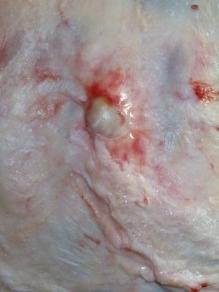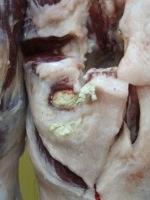In early spring, watch out for these livestock diseases in WA:
| Disease | Typical history and signs |
|---|---|
| Polioencephalomalacia (PEM) |
|
| Worms
|
|
Recent livestock disease cases in WA
Eperythrozoonosis (Mycoplasma ovis) causes death in 30 lambs in the Great Southern
- Lambs still on their mothers presented with anaemia (e.g. pale gums, weakness) and sudden death.
- The lambs had been marked one month prior and given a 6-in-1 and erysipelas vaccination, selenium and vitamin B12 supplementation and drenched against worms. Marking equipment had been disinfected.
- Tests showed the lambs were severely anaemic with large numbers of the blood parasite, Mycoplasma ovis (eperythrozoonosis).
- M. ovis is transmitted via infected blood (e.g. contaminated needles or surgical instruments) or biting insects such as ticks, flies, fleas and mosquitoes. In conjunction with poor nutrition and a heavy worm burden, the disease in lambs can be severe.
- Despite a recent worm drench, the appearance of the intestines suggested prior worm damage.
- Good nutrition, parasite control and reducing handling stress of affected animals can reduce losses until animals recover.
- Outbreaks of the disease are more likely in spring.
- Read more on the DPIRD webpage on eperythrozoonosis.
Weakness and death in lambs in the Wheatbelt due to pulpy kidney (enterotoxaemia)
- The 6-8 week-old lambs displayed unusual behaviour before becoming weak and dying. The lambs had been vaccinated against pulpy kidney at marking 5 weeks prior. The flock was fed on hay, lupins and oats.
- Intestinal contents tested positive for enterotoxaemia toxin and indicated a significant roundworm burden. Given the abnormal behaviour, blood was also tested for lead toxicity (reportable) and the result was negative.
- Pulpy kidney can occur in unvaccinated or incorrectly vaccinated sheep, where there is a sudden change to high carbohydrate, low-fibre feed (e.g. moved to lush pasture/grain) and is more often seen in sheep that are rapidly growing.
- Note: a one-off vaccination is generally not sufficient to provide immunity in previously unvaccinated sheep and lambs. Read more on our website on pulpy kidney vaccination. Avoiding sudden changes in feed quality will also help to prevent the disease occurring.
Abscesses seen in the flank (top) and back/rump (bottom) of a sheep carcass.
Don’t lose profits from vaccination abscesses at abattoir
- Abattoir inspectors have noticed a recent increase in the number of vaccination abscesses in sheep carcasses. These can result in downgrading and removal of sections of a carcass, which can be prime cuts, resulting in reduced profits to the producer.
- Abscesses are normally seen in the neck, rump, flank, back and inner thigh. Sheep vaccines that are designed to be used subcutaneously should only enter the space just below the hide. This area is the junction between the easily pinched hide and the body. Vaccine should be given high in the neck away from prime cuts.
- Using a short needle, angling the needle at 45 degrees to the body and pinching up the hide to stretch the area and injecting are some techniques that can help.
- Abscesses can result from bacteria on the needle or a blunt needle, which is more likely to tear the skin allowing bacteria to enter.
- Read Animal Health Australia’s factsheet for more information.
1000+ reasons for WA’s high animal health status
WA producers and vets are the frontline of the State’s animal health surveillance team and in 2016/17 producers made over 1000 calls to a vet to investigate and submit laboratory samples when animals showed signs of illness.
These investigations help our livestock industries to maintain access to domestic and international markets by providing evidence that we are free of exotic diseases that may look like common endemic diseases and present with signs like sudden death, lameness, unusual behaviour and abortion.
To find out more about how WA’s surveillance system protects our livestock markets, see the new video, Animal Health Surveillance in WA.
Previous issues
Previous issues of WALDO - for vets and WALDO - for producers are available on the newsletter archive page or by searching 'WA livestock disease outlook'.
Feedback
We welcome feedback. To provide comments or to subscribe to the monthly email newsletter, WA livestock disease outlook, email waldo@agric.wa.gov.au.


